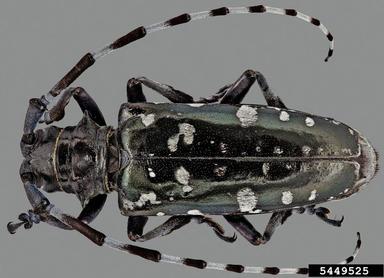Anoplophora glabripennis
Asian Longhorned Beetle
Synonym(s):
Class: Insecta
Order: Coleoptera
Family: Cerambycidae

Photographer: Steven Valley, Oregon Department of Agriculture
Source: bugwood.org
Description
Adult Description: The Asian longhorned beetle (Anoplophora glabripennis) is in the family Cerambycidae, which consists of several genera of wood boring beetles. Considered a relatively large beetle, the adults are usually 0.75-1.25 inches in length. Males and females possess characteristic black and white striped horns that are slightly longer in the males. The thorax has glossy black elytra (hardened wings) with white spots or markings.
Larva Description: Asian longhorned beetle larvae are grub-like, yellow to white, and less than 2.0 inches in length. The eggs are oviposited below the surface of the host tree's bark, so only the adult morphs are typically observed.
Host Plant: Generalist for hardwood trees with a preference for: maple, boxelder, horsechestnut, buckeye, willow, and elm. The Asian longhorned beetle is not limited to these species and has been observed on other hard wood trees from several genera.
Complete host list - provided by USDA-APHIS
Ecological Threat: The Asian longhorned beetle is a threat to several species of hardwood trees because the larvae feed on the phloem and xylem below the bark causing severe damage to the host by tunneling and disrupting sap flow. With the ability to eliminate large populations of trees in metropolitan areas, this beetle poses a threat to forest ecosystems if infestation is facilitated due to its lack of host specificity.
Biology: Eggs are oviposited below the surface of the bark at the xylem level of the tree by female Asian longhorned beetles leaving a visible scar on the surface of the tree, less than 0.5 inches in diameter. Larvae are grub-like, white or yellow in color, and feed on the phloem and xylem of the tree until they reach 2.0 inches in length and undergo metamorphosis into a pupae. Pupae are yellow to orange in color and measure 1.25 inches in length. Following the final stage of metamorphosis from the pupae to the adult form, the beetles bore through the bark and leave the tree to mate. An entire life cycle is completed between 12 and 18 months depending on environmental conditions.
History: The Asian longhorned beetle was first discovered in the Greenpoint neighborhood of Brooklyn, NY in 1996 where it quickly spread to Manhattan and Central Park causing the removal and death of several trees to prevent major losses in the park. The beetle was most likely brought to the United States on wood pallets brought from China in the 1980's carrying materials for a sewer project.
U.S. Habitat: Adult Asian longhorned beetles are present from late spring to early fall and can be found on several species of hard wood trees.
Distribution
Native Origin: China and Korea
U.S. Present: IL, MA, NJ, NY
Management
The only known infestations of the Asian longhorned beetle are in Chicago and New York, with early detection and rapid response methods of management utilized in surrounding areas. The beetle has been observed in shipments of wood at several locations across the United States, but infestations have been prevented. There are no known methods of chemical or herbicidal eradication, but the USDA and APHIS are working to develop these products to eradicate the species in the known infested areas. It is important to notify local forest authorities if an alleged Asian longhorned beetle has been sighted. If identified, any host trees will be removed rapidly with replacement planting to prevent establishment of the beetle in a new area.
References
Haack , Robert A., Franck Hérard , Jianghua Sun , and Jean J. Turgeon. 2010. Managing invasive populations of Asian longhorned beetle and citrus longhorned beetle: a worldwide perspective. Annual Review of Entomology 55: 521-546.
Woodward, Susan L., and Joyce Ann. Quinn. 2011. Asian Longhorned Beetle. Encyclopedia of Invasive Species: From Africanized Honey Bees to Zebra Mussels. Santa Barbara, CA: Greenwood. 113-15. Print.
Internet Sources
 Texas Invasive Species Institute
Texas Invasive Species Institute